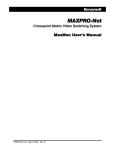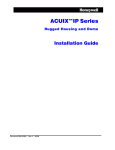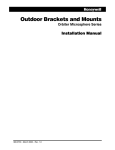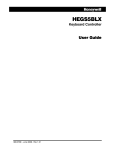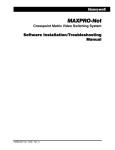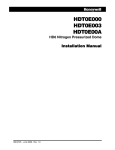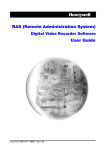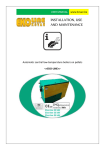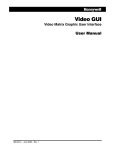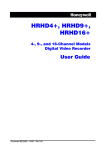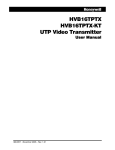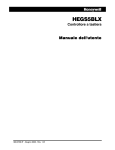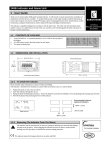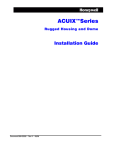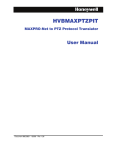Download Installation Manual
Transcript
HD6 Series Housings Installation Manual 900.0696 August 2006 Rev. 1.02 ISSUE DATE 1.0 December 2005 1.01 June 2006 1.02 August 2006 Rev. 1.02 REVISIONS Initial Release Remove Ultradome; revise power wiring distance chart; changed CAT5 to UTP; removed UTC option Revised Important Safeguards regarding Installation and water/moisture for specific housing types. ii 900.0696 1-Aug-06 FCC COMPLIANCE STATEMENT INFORMATION TO THE USER: This equipment has been tested and found to comply with the limits for a Class A digital device, pursuant to part 15 of the FCC rules. These limits are designed to provide reasonable protection against harmful interference when the equipment is operated in a commercial environment. This equipment generates, uses, and can radiate radio frequency energy and, if not installed and used in accordance with the instruction manual, may cause harmful interference to radio communications. Operation of this equipment in a residential area is likely to cause harmful interference in which case the user will be required to correct the interference at his own expense. CAUTION: Changes or modifications not expressly approved by the party responsible for compliance could void the user’s authority to operate the equipment. This Class A digital apparatus complies with Canadian ICES-003. Cet appareil numérique de la Classe A est conforme à la norme NMB-003 du Canada. EXPLANATION OF GRAPHICAL SYMBOLS The lightning flash with arrowhead symbol within an equilateral triangle is intended to alert the user to the presence of uninsulated "dangerous voltage" within the product's enclosure that may be of sufficient magnitude to constitute a risk of electric shock to persons. The exclamation point within an equilateral triangle is intended to alert the user to the presence of important operating and maintenance (servicing) instruction in the literature accompanying the product. CAUTION RISK OF ELECTRIC SHOCK DO NOT OPEN CAUTION: TO REDUCE THE RISK OF ELECTRIC SHOCK, DO NOT REMOVE COVER (OR BACK). NO USER-SERVICEABLE PARTS INSIDE. REFER SERVICING TO QUALIFIED SERVICE PERSONNEL. Rev. 1.02 iii 900.0696 1-Aug-06 Rev. 1.02 iv 900.0696 1-Aug-06 IMPORTANT SAFEGUARDS 1. READ INSTRUCTIONS – All of the safety and operating instructions should be read before the appliance is operated. 2. RETAIN INSTRUCTIONS – The safety and operating instructions should be retained for future reference. 3. HEED WARNINGS – All warnings on the unit and in the operating instructions should be adhered to. 4. FOLLOW INSTRUCTIONS – All operating and use instructions should be followed. 5. CLEANING – Unplug the unit from the outlet before cleaning. Do not use liquid cleaners or aerosol cleaners. Use a damp cloth for cleaning. 6. ATTACHMENTS – Do not use attachments not recommended by the product manufacturer as they may result in the risk of fire, electric shock, or injury to persons. 7. INSTALLATION – The indoor housings and rugged dome housing are not designed to be waterproof. Exposure to rain or water may damage the unit. The weather dome housing is designed to be installed in an outdoor environment and is waterproof when installed and sealed as recommended in this manual. 8. WATER AND MOISTURE: Indoor Housings and Rugged Dome Housing - Do not use these units near water or in an unprotected outdoor installation, or any area classified as a wet location. Weather Dome Housing – These units can be installed in an outdoor environment provided they are installed and sealed as recommended in this manual. 9. ACCESSORIES - Do not place this product on an unstable cart, stand, tripod, bracket, or table. The product may fall, causing serious injury to a child or adult and serious damage to the equipment. Use only with a cart, stand, tripod, bracket, or table recommended by the manufacturer, or sold with the product. Any mounting of the product should follow the manufacturer’s instructions and should use a mounting accessory recommended by the manufacturer. Wall or shelf mounting should follow the manufacturer’s instructions and should use a mounting kit approved by the manufacturer. 10. A product and cart combination should be moved with care. Quick stops, excessive force, and uneven surfaces may cause the product and cart combination to overturn. 11. VENTILATION - Slots and openings in the cabinet and the back or bottom are provided for ventilation and to ensure reliable operation of the equipment and to protect it from overheating. These openings must not be blocked or covered. The openings should never be blocked by placing the product on a bed, sofa, rug, or other similar surface. Equipment should never be placed near or over a radiator or heat register. This product should not be placed in a built-in installation, such as a bookcase or rack unless proper ventilation is provided or the manufacturer’s instructions have been adhered to. 12. POWER SOURCES – This product should be operated only from the type of power source indicated on the marking label. If you are not sure of the type of power supplied to your facility, consult your product dealer or local power company. For products designed to operate from battery power or other sources, refer to the operating instructions. 13. GROUNDING OR POLARIZATION – The power supply supplied with this unit may be equipped with a polarized alternating-current line plug (a plug having one blade wider than the other). This plug will fit into the power outlet only one way. This is a safety feature. If you are unable to insert the plug fully into the outlet, try reversing the plug. If the plug should still fail to fit, contact your electrician to replace your obsolete outlet. Do not defeat the safety purpose of the polarized plug. 14. OVERLOADING – Do not overload outlets and extension cords as this can result in a risk of fire or electric shock. Rev. 1.02 v 900.0696 1-Aug-06 IMPORTANT SAFEGUARDS, CONTINUED 15. POWER-CORD PROTECTION – Power supply cords should be routed so that they are not likely to be walked on or pinched by items placed upon or against them, paying particular attention to cords and plugs, convenience receptacles, and the point where they exit from the monitor. 16. OBJECT AND LIQUID ENTRY – Never push objects of any kind into this unit through openings as they may touch dangerous voltage points or short-out parts that could result in a fire or electric shock. Never spill liquid of any kind on the unit. 17. SERVICING – Do not attempt to service this unit yourself as opening or removing covers may expose you to dangerous voltage or other hazards. Refer all servicing to qualified service personnel. 18. DAMAGE REQUIRING SERVICE – Unplug the unit from the outlet and refer servicing to qualified service personnel under the following conditions: a. When the power-supply cord or plug is damaged. b. If liquid has been spilled, or objects have fallen into the unit. c. Indoor Housings and Rugged Dome Housing - If the unit has been exposed to rain or water. d. If the unit does not operate normally by following the operating instructions. Adjust only those controls that are covered by the operating instructions as an improper adjustment of other controls may result in damage and will often require extensive work by a qualified technician to restore the unit to its normal operation. e. If the unit has been dropped or the enclosure has been damaged. f. When the unit exhibits a distinct change in performance - this indicates a need for service. 19. REPLACEMENT PARTS – When replacement parts are required, be sure the service technician has used replacement parts specified by the manufacturer or have the same characteristics as the original part. Unauthorized substitutions may result in fire, electric shock or other hazards. 20. SAFETY CHECK – Upon completion of any service or repairs to this unit, ask the service technician to perform safety checks to determine that the unit is in proper operating condition. 21. LIGHTNING AND POWER LINE SURGES – For added protection of this unit during a lightning storm, or when it is left unattended and unused for long periods of time, unplug it from the wall outlet and disconnect the cable system. This will prevent damage to the unit due to lightning and power-line surges. 22. HEAT – The product should be situated away from heat sources such as radiators, heat registers, stoves, or other products (including amplifiers) that produce heat. 23. WALL OR CEILING MOUNTING – The product should be mounted to a wall or ceiling only as recommended by the manufacturer. Rev. 1.02 vi 900.0696 1-Aug-06 IMPORTANT NOTICE All companies make changes and improvements in their products. Because this product can be set up to interface with equipment not manufactured by Honeywell Video Systems, there is a possibility that the interface protocols may have changed since Honeywell Video Systems tested this product with the interfacing equipment. Therefore, this unit may not be currently compatible with equipment produced by other manufacturers. The existence of past successful installations proves our intent to provide equipment compatible with other manufacturers, but does not guarantee success. Honeywell Video Systems recommends purchasing a single unit for bench testing prior to purchasing and installing this product in quantity. Should any problems occur, Honeywell Video Systems will provide technical support (at the user’s expense) to analyze the interface protocols of your system. The end user must agree to give Honeywell Video Systems reasonable access to the system in order to study and correct the protocol incompatibility. In the event that Honeywell Video Systems is unable to make the units work together in the system, we will accept the return of any Honeywell Video Systems products associated with the installation and refund the amounts paid for these products. Because Honeywell Video Systems recommends bench testing the equipment prior to installation, we will not be liable for any installation cost, lost revenues, or other cost resulting from the incompatibility. Rev. 1.02 vii 900.0696 1-Aug-06 Notes: Rev. 1.02 viii 900.0696 1-Aug-06 TABLE OF CONTENTS SECTION 1: INTRODUCTION .................................................................................................................. 1 1.1 PRODUCT DESCRIPTION .................................................................................................................. 1 1.2 RECOMMENDED CABLING AND CONNECTORS ............................................................................. 1 SECTION 2: BASIC INSTALLATION ........................................................................................................ 3 2.1 DROPPED CEILING HOUSING........................................................................................................... 3 2.2 HARD CEILING HOUSING .................................................................................................................. 5 2.3 PENDANT DOME HOUSING .............................................................................................................. 7 2.4 HD6 RUGGED DOME HOUSING...................................................................................................... 10 2.5 WEATHER DOME HOUSING ............................................................................................................ 15 SECTION 3: WIRING THE HOUSING..................................................................................................... 19 3.1 INTRODUCTION................................................................................................................................ 19 3.1.1 3.1.2 3.1.3 3.1.4 Power............................................................................................................................ 19 Control Data.................................................................................................................. 21 Video............................................................................................................................. 23 Alarm............................................................................................................................. 23 3.2 WIRING – STANDARD....................................................................................................................... 24 3.2.1 3.2.1 3.2.2 3.2.3 3.2.4 Dropped / Hard Ceiling Installation .............................................................................. 24 Dropped / Hard Ceiling Installation, Continued ........................................................... 25 Pendant Dome Installation ........................................................................................... 27 HD6 Rugged Housing Installation ................................................................................ 29 Weather Dome Installation ........................................................................................... 30 3.3 WIRING – UNSHIELDED TWISTED PAIR (UTP) OPTION................................................................. 33 3.3.1 3.3.2 3.3.3 Rev. 1.02 Dropped Ceiling / Hard Ceiling / Pendant Dome Installation....................................... 33 HD6 Rugged Housing Installation ................................................................................ 37 Weather Dome Installation ........................................................................................... 39 ix 900.0696 1-Aug-06 LIST OF FIGURES Figure 1: Dropped Ceiling Housing Installation Figure 2: Hard Ceiling Housing Installation Figure 3: Pendant Dome Housing Installation Figure 4: Safety Cable Installation Figure 5: Installing Conduit Fitting In Housing Figure 6: Mounting Bracket Hole Detail Figure 7: Changing Orientation of the Bracket Figure 8: Heater/Blower Option Figure 9: Safety Cable Installation Figure 10: Standard Wiring – Dropped / Hard Ceiling Installation Figure 11: Installing Top Plate in Housing Figure 12: Standard Wiring – Pendant Housing Figure 13: Standard Wiring – HD6 Rugged Housing Installation Figure 14: Standard Wiring – HD6 Weather Dome – No Connector Figure 15: Standard Wiring – HD6 Weather Dome –14-pin Connector Figure 16: Unshielded Twisted Pair (UTP) Option Wiring – Hard / Dropped / Pendant Housing Figure 17: Unshielded Twisted Pair (UTP) Option – HD6 Rugged Dome Figure 18: Unshielded Twisted Pair (UTP) Option – HD6 Weather Dome – No Connector Rev. 1.02 x 3 5 7 10 11 12 13 14 16 25 26 28 29 31 32 36 38 40 900.0696 1-Aug-06 SECTION 1: INTRODUCTION 1.1 PRODUCT DESCRIPTION An HD6 is a pan and tilt mechanism containing a camera and lens that is controlled remotely by an operator using a Diamond series, Maxpro series, Pelco (P and D code only), or VCL control system. The HD6 is enclosed in a housing for dropped or hard ceiling applications or in a pendant dome for indoor applications. The HD6 is housed in a Weather Dome or Rugged Dome for outdoor applications. For nitrogen pressurized applications, refer to the Nitrogen Pressurized Dome Installation Manual. The whole assembly is often referred to as a "dome". The pan and tilt mechanism with camera and lens is often referred to as a "scan". The indoor pendant housing can be mounted on a Honeywell Video Systems indoor pendant ceiling dome mount or indoor wall dome mount. The weather dome can be mounted on a Honeywell Video Systems outdoor wall mount, pendant mount, roof mount, or parapet mount. This installation guide provides instructions for mounting the different types of housing s. Refer to the User Manual for operation and programming information. 1.2 RECOMMENDED CABLING AND CONNECTORS Type Recommended Cable Part Number Maximum Distance Video Coax, RG-59/U, 75 Ohms BNC Connector, Crimp On for RG-59/U BNC Connector, Screw Type for RG-59/U 849518-0054 842374-0194 842374-0391 1000 Feet (305 Meters) Data Twisted Shielded Pair, RS-422 Data 849518-0334 4000 Feet (1219 Meters) Power 18 AWG 2-Conductor , Vinyl Jacket 849518-0336 See Gauge Chart for Each Unit Alarm Belden 8205 849518-0217 10,000 Feet Unshielded Twister Pair (UTP) Option UTP Cabling 1 twisted pair for data 1 twisted pair for video 849518-0399 DIP Switch Selectable 0-300 (0-90 Meters) 300-600 (90-180 Meters) 600-900 (180-270 Meters) 900-1200 (270-365 Meters) 1200-1500 (365-455 Meters) UTP Receiver required at monitor 843216-0953 1500 Feet (455 Meters) Digital Interface Option Rev. 1.02 CAT5 Cable with an RJ-45 Connector for 10baseT or 100baseT Ethernet 1 900.0696 1-Aug-06 Notes: Rev. 1.02 2 900.0696 1-Aug-06 SECTION 2: BASIC INSTALLATION 2.1 DROPPED CEILING HOUSING WARNING: Installation must be performed by qualified technical personnel and must be in accordance with all national and local mechanical and electrical codes. Perform the following steps to install a dropped ceiling housing . Refer to Figure 1 HOUSING APPROX 5.00 (127) SAFETY CABLE TIE POINT (METAL TAB WITH HOLE ON SIDE OF CAN) CONNECT SECURELY TO BUILDING SUPPORT STRUCTURE CABLE CLAMP SPRING LATCH (RELEASES TOP PLATE) SCAN ALIGNMENT STUDS LOWER DOME MOUNTING POSTS (3 PLACES) CUT-OUT IN CEILING TILE 7 5/8” DIA. (193.8) DROPPED CEILING PLATE WING TAB (3 PLACES) CUSTOMER 2 FT SPAN DROPPED CEILING GRID SUPPORTS TURN SCREW CLOCKWISE TO EXTEND SUPPORT CLAMPS AND SECURE DOME TO CEILING (TYPICAL 3 PLACES) ATTACH LANYARD TO BOTTOM .62 (15.7) DROPPED CEILING TILE Figure 1: Dropped Ceiling Housing Installation 1. Select the location(s) of the housing (s). Each HD6 requires a 24Vac ± 10% power source when measured at the dome. Ensure a 24Vac @ 1.1A power source is available at the dome. Refer to Section 3.1.1 for maximum wiring distances to the dome. 2. Remove the ceiling panel (2’x4’ or 2’x2’) at the dome location. 3. Place the ceiling tile on the dropped ceiling plate. Trim the ceiling tile so you can press the ceiling tile into the dropped ceiling plate. 4. Cut a hole in the ceiling tile flush with the hole in the center of the plate. 5. Secure a safety cable (supplied by installer) to a building support structure. Honeywell Video Systems recommends using 3/32” plastic coated aircraft cable (part 849518-0311) and looping sleeves (part 849511-0057). These parts can be ordered from the Honeywell Video Systems parts department. Rev. 1.02 3 900.0696 1-Aug-06 2.1 DROPPED CEILING HOUSING, CONTINUED 6. Place the housing in the ceiling mount. The space between the wing tabs on the housing and the housing flange should be greater than the thickness of the ceiling tile and the mount. Make sure the wing tabs on the housing are staggered so the tabs are not at the same height. 7. Position the wing tabs flat against the housing . Push the housing through the hole in the ceiling tile and the mount (some jostling is required). Using a screwdriver, turn the three screws in the housing clockwise to rotate the tabs out and tighten the tabs against the ceiling mount. 8. Attach the safety cable (from the building support structure) to the housing by threading the cable through a looping sleeve, through the hole in the tab (beside the conduit fitting) on the housing , and then through the looping sleeve again. Secure by crimping the looping sleeve. The safety cable tab on the housing can be rotated as needed for clearance in the ceiling. 9. Place the ceiling tile with the plate and the housing on the ceiling support grid. 10. Refer to Section 3 for wiring instructions. Refer to Section 3.2 for standard wiring. Refer to Section 3.3 for Unshielded Twisted Pair (UTP) wiring. Rev. 1.02 4 900.0696 1-Aug-06 2.2 HARD CEILING HOUSING WARNING: Installation must be performed by qualified technical personnel and must be in accordance with all national and local mechanical and electrical codes. Perform the following steps to install a HD6 hard ceiling dome. Refer to Figure 2. SAFETY CABLE TIE POINT (METAL TAB WITH HOLE ON SIDE OF CAN) CONNECT SECURELY TO BUILDING SUPPORT STRUCTURE HOUSING Compass Tool (part number 518058-2120) Pin APPROX 5.00 (127) CABLE CLAMP SPRING LATCH (RELEASES TOP PLATE) SCAN ALIGNMENT STUDS CUT-OUT IN CEILING 7 5/8” DIA. (193.8) SEAL CUT-OUT USING TAPE OR PLASTIC CHANNEL (SUPPLIED BY INSTALLER) Hole WING TAB (3 PLACES) DRYWALL CEILING TURN SCREW CLOCKWISE TO EXTEND SUPPORT CLAMPS AND SECURE DOME TO CEILING (TYPICAL 3 PLACES) LOWER DOME MOUNTING POSTS (3 PLACES) ATTACH LANYARD TO BOTTOM Figure 2: Hard Ceiling Housing Installation 1. Select the location(s) of the housing (s). Each HD6 requires a 24Vac ± 10% power source when measured at the dome. Ensure a 24Vac @ 1.1A power source is available. Refer to Section 3.1.1 for maximum wiring distances to the dome. 2. Cut a 7–5/8" (193.8mm) diameter hole in the ceiling using the compass tool (part number 518058-2120) provided with the hard ceiling housing . See Figure 2. a. Drill a 1/8” diameter hole in the ceiling where the center of your dome is to be located. b. Insert the pin on the tool in the drilled hole. c. Scribe a line on the ceiling using the hole in the other end of the tool. d. Cut out the hole for the housing using the scribed line. Rev. 1.02 5 900.0696 1-Aug-06 2.2 HARD CEILING HOUSING, CONTINUED 3. If the ceiling is drywall or plaster, Honeywell Video Systems recommends sealing the entire perimeter of the ceiling cut-out with tape or plastic channel (provided by installer). This prevents dust and material from dropping from ceiling. 4. Secure a safety cable (supplied by installer) to a building support structure in the ceiling. Honeywell Video Systems recommends using 3/32" plastic coated aircraft cable (part number 849518-0311) and splicing sleeves (part number 849511-0057). These parts can be ordered from the Honeywell Video Systems parts department. 5. Attach the safety cable (from the building support structure) to the housing by threading the cable through a splicing sleeve, through the hole on the metal tab (beside conduit fitting) on the housing , and then through the splicing sleeve again. Secure by crimping the splicing sleeve. The safety cable tab can be rotated as required for clearance in ceiling. 6. Insert the housing in the ceiling. a. Make sure the space between the wing tabs on the housing and the housing flange is greater than the thickness of the ceiling. Make sure the wing tabs on the housing are staggered so the tabs are not at the same height. b. Position the wing tabs flat against the housing . Insert the housing through the hole in the ceiling (some jostling is required). Using a Phillips screwdriver, turn the three screws in the housing clockwise to rotate the tabs out and tighten the tabs against the ceiling. 7. Refer to Section 3 for wiring information. Refer to Section 3.2 for standard wiring. Refer to Section 3.3 for Unshielded Twisted Pair (UTP) wiring. Rev. 1.02 6 900.0696 1-Aug-06 2.3 PENDANT DOME HOUSING WARNING: Installation must be performed by qualified technical personnel and must be in accordance with all national and local mechanical and electrical codes. Perform the following steps to install a HD6 pendant dome on a Honeywell Video Systems indoor wall or ceiling pendant dome mount: INSERT PIN FOR SAFETY CABLE BLACK NIPPLE SAFETY CABLE INSTALLATION MOUNTING HOLES (3 PLACES) TOP PENDANT HOUSING ATTACH THE SAFETY CABLE TO A BUILDING SUPPORT STRUCTURE SPLICING SLEEVE SAFETY CABLE SPRING LATCH (RELEASES TOP PLATE) SCAN ALIGNMENT STUDS SPLICING SLEEVE LOOP AROUND 1/4” DIA x 1-3/4” LG. PIN INSERTED IN TOP OF DOME LOWER DOME MOUNTING POSTS (3 PLACES) DETAIL A (SUPPLIED BY INSTALLER) Figure 3: Pendant Dome Housing Installation 1. Select the location(s) of the housing (s). Each HD6 requires a 24Vac ± 10% power source measured at the dome. Ensure a 24Vac @ 1.1A power source is available. 2. Install the mount using the instructions provided with your specific mount. Rev. 1.02 7 900.0696 1-Aug-06 2.3 PENDANT DOME HOUSING , CONTINUED 3. Run the field wiring (control data, video, power, and alarm) and a safety cable (secured to a building support structure) through the mount. Honeywell Video Systems recommends using 3/32” plastic coated aircraft cable (part number 849518-0311) and looping sleeves (part number 849511-0057) for the safety cable. (Refer to Detail A in Figure 3.) The safety cable materials may be purchased from the Honeywell Video Systems parts department. The wiring and safety cable must extend at least one foot past the pipe for wiring purposes. Refer to Section 3 for detailed wiring information. WARNING: If installing the pendant dome on a threaded mount, do not attach the safety cable to a building support structure until after the dome is threaded onto the mount. 4. Locate the housing decorative cover flange supplied with the mount. Refer to the instructions provided with your specific mount. Slide the flange over the cabling and up onto the mount. Secure the flange temporarily (use tape) to the mount out of the way of the cabling. 5. Locate the pendant housing. a. Using a screwdriver, remove the two hairpin clips securing the ¼” pin in the black nipple. Slide the ¼” pin out of the black nipple. Remove the black dust cover plug by inserting a screwdriver in the slot of the plug and pulling the plug out of the nipple. Set the clips and pin aside. (They will be reinstalled later.) Discard the dust cover plug. b. Remove the top plate (located in the top of the pendant housing) by pressing the spring latch on the top plate until the top plate is released, then lower the top plate down. c. Insert the field wiring (data, power, video, and alarm) from the mount through the black nipple on the pendant housing. d. Insert the ¼” pin in the ¼” holes in the black threaded nipple on the pendant housing. e. Secure the pin on each end using the two hairpin clips. f. Rev. 1.02 Route the safety cable (attached to the building support structure) through a splicing sleeve, around the pin in the housing, and then through the sleeve again. Secure the safety cable by crimping the sleeve using a crimping tool. See Figure 3, Detail A. 8 900.0696 1-Aug-06 2.3 PENDANT DOME HOUSING, CONTINUED g. Carefully slide the black nipple on the pendant housing into the mounting pipe. If installing the dome on a threaded mount, thread the dome into the mount at this time then connect the safety cable to a building support structure. WARNING: Do not force the dome into the mount; the threads on the dome are plastic and could be damaged if force is used. h. Line up the three mounting holes on the housing with the holes in the mount piping. Use the three self-tapping hex head screws supplied with the mount to secure the dome to the mount. i. Slide the decorative cover flange on the mount (step 4 above) over the black nipple on the housing. 6. Connect the field wiring to the housing mounting plate (removed in step 5 above). Refer to Section 3 for wiring information. Refer to Section 3.2 for standard wiring. Refer to Section 3.3 for Unshielded Twisted Pair (UTP) wiring. Rev. 1.02 9 900.0696 1-Aug-06 2.4 HD6 RUGGED DOME HOUSING WARNING: Installation must be performed by qualified technical personnel and must be in accordance with all national and local mechanical and electrical codes. Perform the following steps to install a rugged dome housing. 1. Select the location(s) of the housing (s). Each HD6 requires a 24Vac ± 10% power source measured at the dome. Ensure a 24Vac @ 1.1A power source is available. The blower only option requires an additional 24Vac @ 0.5A power source. 2. Secure a safety cable (supplied by installer) to a building support structure. Honeywell Video Systems recommends using 3/32" plastic coated aircraft cable (part 849518-0311) and splicing sleeves (part 849511-0057). These parts can be ordered from the Honeywell Video Systems parts sales department. SAFETY CABLE INSTALLATION ATTACH THE SAFETY CABLE TO A BUILDING SUPPORT STRUCTURE SPLICING SLEEVE SAFETY CABLE SPLICING SLEEVE LOOP THROUGH HOLE IN MOUNTING BRACKET (SAFETY CABLE SUPPLIED BY INSTALLER) Figure 4: Safety Cable Installation 3. Attach the safety cable from the building structure to the mounting bracket. Route the safety cable through one side of a splicing sleeve (not supplied), then through the hole in the side of the mounting bracket, then through the other side of the splicing sleeve. Secure the safety cable by crimping the splicing sleeve. Rev. 1.02 10 900.0696 1-Aug-06 2.4 HD6 RUGGED DOME HOUSING , CONTINUED 4. Locate the housing and set the jumpers and switches as applicable on the circuit board. Refer to Section 3 for wiring information. Refer to Section 3.2 for standard wiring. Refer to Section 3.3 for Unshielded Twisted Pair (UTP) wiring. 5. After completing wiring, continue basic installation for HD6 Rugged Dome housing. 6. Install a ¾” conduit fitting (not supplied) in the hole on the housing. Place the supplied washer between the hole in the housing and the conduit fitting to prevent leakage. Tighten the conduit nut to secure the fitting to housing and prevent leakage. Conduit Fitting Conduit Nut Housing Washer Figure 5: Installing Conduit Fitting In Housing Rev. 1.02 11 900.0696 1-Aug-06 2.4 HD6 RUGGED DOME HOUSING , CONTINUED 7. Mount the housing to a ceiling support structure or wall support structure. The installer supplies the mounting hardware. There are four sets of mounting holes. 1.930 .313 TYP. 3.500 .300 TYP. .437 TYP. 1.150 3.500 2.625 1.000 1.150 2.625 6. 500 Figure 6: Mounting Bracket Hole Detail a. The mounting bracket can be positioned between 0°-45° or 45°-90° depending on the orientation of the mounting bracket on the housing. To change the orientation of the bracket, remove the four nuts, lock washers and bolts that secure the bracket to the housing. Flip the bracket over and secure the bracket to the housing using the four nuts, lock washers, and bolts. b. The mounting bracket can be repositioned by loosening the four nuts (two on each side) inside the housing and sliding the bracket along the slot. Tighten the four nuts to secure the bracket at the desired angle. c. Secure the mount to the wall or ceiling using the appropriate hardware for the mounting surface. NOTE: The mounting bracket can be at any angle from 0° to 90° with respect to the housing. The housing must be positioned horizontal and parallel with the floor. Rev. 1.02 12 900.0696 1-Aug-06 2.4 HD6 RUGGED DOME HOUSING , CONTINUED To change orientation of bracket: 1. Remove nuts, lockwashers, and bolts 2. Flip bracket 3. Insert bolts (4) in slots and hole, and 4. Secure with lockwashers and nuts. 45 - 90 degrees 0°-90° 0°-45° 0 - 45 degrees Loosen nuts (2 each side) to slide bracket along slot to change angle Loosen nuts (2 each side) to slide bracket along slot to change angle Figure 7: Changing Orientation of the Bracket 8. Route the field-run wiring (data, HD6 power, video, and heater or blower power) through the conduit fitting to the appropriate position on the terminal strips in the housing. The terminal strips are labeled to show the function of each position. NOTE: Do not connect the data cable shield at the terminal strip. The terminal strips TB1 and TB2 accept 18-24 AWG wire. If larger or smaller field-run wire is required, an 18-24 AWG wire must be spliced onto the field wire for insertion into the terminal strip. Refer to Section 3 for wiring information. Refer to Section 3.2 for standard wiring. Refer to Section 3.3 for Unshielded Twisted Pair (UTP) wiring. Refer to Figure 8 if the heater/blower or blower option is installed. a. Flip up the tab on the terminal strip. b. Strip the insulation on the wire back approximately 7/16”. c. Insert the wire fully in the hole on the terminal strip to ensure a good contact and to ensure it does not short to adjacent wires. d. Push the tab down to secure the wire. Rev. 1.02 13 900.0696 1-Aug-06 2.4 HD6 RUGGED DOME HOUSING , CONTINUED 9. If the heater/blower option or blower option is installed, route the 24Vac wiring through the conduit fitting and connect at terminal strip TB4 on the heater/blower board. See Figure 8. a. Loosen the screw on the terminal strip. b. Strip the insulation on the wire back approximately 7/16”. c. Insert the wire fully in the hole on the terminal strip to ensure a good contact and to ensure it does not short to adjacent wires. d. Tighten the screw on the terminal strip to secure the wire. HEATER/BLOWER POWER REQUIREMENTS 24VAC @ 4A 24 VAC HEATER POWER MAXIMUM WIRE LENGTHS AWG MAX. DISTANCE TO DOME 62 FEET (19 METERS) 18 99 FEET (30 METERS) 16 158 FEET (48 METERS) 14 251 FEET (76 METERS) 12 24VAC POWER CONNECTIONS THERMOSTAT: Heater/Blower Option Power Terminal Strip TB4-1 24VAC TB4-2 24VAC ON 70 F OFF 90 F OUTPUT 96W BLOWER ONLY POWER REQUIREMENTS 24VAC @ 0.5A 24 VAC HEATER POWER MAXIMUM WIRE LENGTHS AWG MAX. DISTANCE TO DOME 150 FEET (45 METERS) 22 235 FEET (70 METERS) 20 375 FEET (110 METERS) 18 600 FEET (180 METERS) 16 950 FEET (290 METERS) 14 1500 FEET (455 METERS) 12 Figure 8: Heater/Blower Option 10. Connect the video coaxial cable to the BNC connector in the housing . The installer must supply the mating BNC connector. NOTE: If the Unshielded Twisted Pair (UTP) option is installed, the BNC connector is not used. 11. Feed the excess cabling from the terminal strips and the video cabling back through the conduit fitting and tighten the cable clamp on the fitting (if applicable). 12. Refer to the HD6 Series User Manual to install the scan. Rev. 1.02 14 900.0696 1-Aug-06 2.5 WEATHER DOME HOUSING WARNING: Installation must be performed by qualified technical personnel and must be in accordance with all national and local mechanical and electrical codes. Perform the following steps to install a HD6 weather dome on a Honeywell Video Systems outdoor mount with an ELL conduit fitting or an MDW1210W mount. 1. Select the location(s) of the housing (s). Each HD6 requires a 24Vac ± 10% power source measured at the dome. Ensure a 24Vac @ 1.1A power source is available. An additional 24Vac @ 4A power source is required for the heater/blower installed in the weather dome. 2. Install the mount using the instructions provided with your specific mount. Run the required field wiring and safety cable through the mount for the HD6 weather dome. The field wiring and safety cable are the responsibility of the installer. Honeywell Video Systems recommends using 3/32” plastic coated aircraft cable, part number 849518-0311, for the safety cable and looping sleeves, part number 849511-0057. NOTE: Only the weather or pressurized domes with No Connector is compatible with the MDW1210W mount. 3. Refer to Section 3 for wiring information. Refer to Section 3.2 for standard wiring. Refer to Section 3.3 for Unshielded Twisted Pair (UTP) wiring. 4. Locate the 1-1/2” NPT conduit nut shipped loose with the mount. Thread the conduit nut onto the black threaded nipple on the weather dome with the teeth on the nut away from the dome. 5. Wrap Teflon tape (installer supplied) around the black threaded nipple on the weather dome. 6. Attach the safety cable from the building structure to the weather dome. Use a looping sleeve, (part number 849511-0057) (not supplied) to secure the safety cable. Route the safety cable through one side of the looping sleeve, around the pin in the weather dome, and through the other side of the looping sleeve. Secure the safety cable by crimping the looping sleeve. (See Figure 9). Rev. 1.02 15 900.0696 1-Aug-06 2.5 WEATHER DOME HOUSING , CONTINUED SAFETY CABLE INSTALLATION (SUPPLIED BY INSTALLER) ATTACH THE SAFETY CABLE TO A BUILDING SUPPORT STRUCTURE SPLICING SLEEVE SAFETY CABLE SPLICING SLEEVE LOOP AROUND PIN IN BLACK NIPPLE OF WEATHER DOME Figure 9: Safety Cable Installation 7. Install the weather dome on the mount. Carefully push the cabling from the weather dome up into the mount and thread the weather dome into the threaded pipe on the mount. CAUTION: Do not force the dome into the threaded pipe. The nipple on the weather dome is plastic and the threads on the nipple could be stripped if force is used. 8. After the weather dome is threaded into the mount as far as it will go, thread the conduit nut on the weather dome up against the mount and tighten. Seal the joint between the mount and the black nipple on the weather dome with Dow RTV 3145. 9. Connect mating connector J2 (field wiring) in the mount to connector P2 on the weather dome (on 14-pin connector version only.) 10. Replace the cover on the mount conduit box or access hole cover plate on the MDW1210W mount using the two screws removed when installing the mount. CAUTION: Ensure all field wiring is pushed back into the mount pipe. Ensure the gasket between the conduit box or mount and the cover is seated properly. Rev. 1.02 16 900.0696 1-Aug-06 2.5 WEATHER DOME HOUSING , CONTINUED 11. Seal all joints and screws in the outdoor mount. Use Dow 3145 RTV for Allen head screws, bolts, joints, and all mounting surfaces. Use Teflon tape for threaded joints. CAUTION: All joints, bolts, and screws in the mount must be sealed to prevent water (moisture) from entering the weather dome. 12. Refer to the HD6 Series User Manual to install the scan. Rev. 1.02 17 900.0696 1-Aug-06 Notes: Rev. 1.02 18 900.0696 1-Aug-06 SECTION 3: WIRING THE HOUSING 3.1 INTRODUCTION The field wiring for an indoor HD6 is connected at a terminal strip in the housing or pendant dome. The field wiring for an outdoor HD6 is connected at a CPC connector (J2) or to fly-leads on the housing. Refer to the information specified in the installation instructions for wiring connections. 3.1.1 Power Each camera assembly or scan requires a 24Vac power supply @ 1.1A measured at the dome. The following table shows the wire gauge required for maximum distances to maintain 24V ac ± 10% at the dome. These wire sizes and distances represent one power source for one HD6. Maximum Distance to Dome AWG 24 VAC Camera Only (1.1A) 24 VAC Blower Only (0.5A) 24 VAC Heater & Blower Only (4A) 24 VAC Camera plus Blower (1.6A) 24 VAC Camera plus Heater & Blower (6.0A) 22 65 ft (19m) 150 ft (45m) Not Recommended 45 ft (13m) Not Recommended 20 100 ft (30m) 235 ft (70m) Not Recommended 70 ft (21m) Not Recommended 18 160 ft (48m) 375 ft (110m) 62 (19m) 110 (33m) Not Recommended 16 260 ft (79m) 600 ft (180m) 99 (30m) 175 (53m) 48 (14m) 14 420 ft (128m) 950 ft (290m) 158 (48m) 280 (85m) 75 (22m) 12 650 ft (198m) 1500 ft (455m) 251 ft (76m) 450 ft (137m) 120 (36m) The power supply on the scan is isolated so more than one scan can be powered from the same power source. Rev. 1.02 19 900.0696 1-Aug-06 3.1 FIELD WIRING, CONTINUED CAUTION: Installation must be performed by a qualified electrician. The proper wire size for the distance and the number of scans must be determined to maintain 24V ac at each scan. Do not use the above table for this configuration. For CE compliance, the HD6 power supply must be connected to a CE approved 240V UPS (uninterruptible power supply). One of the following power supplies must be used to meet FCC and UL requirements. HPTV2404 HPTV2404CB HPTV2404WP HPTV2404WP-2 HPTV2401S HPTV2401Z HPTV2401WPS HPTV2401WPZ Rev. 1.02 4 Output, 24Vac, 4A 4 Output, 24Vac, 4A, PTC 4 Output, 24Vac, 4A. NEMA4X Weatherproof enclosure. 4 Output, 24Vac, 8A, NEMA4X Weatherproof enclosure. Single Output 24Vac, 8A, Indoor (includes power and video surge suppression) Single Output 24Vac, 8A, Indoor (includes power, video, and data surge suppression) Single Output 24Vac, 8A, Weatherproof (includes power and video surge suppression) Single Output 24Vac, 8A, Weatherproof (includes power, video, and data surge suppression) 20 900.0696 1-Aug-06 3.1 FIELD WIRING, CONTINUED 3.1.2 Control Data On standard HD6 units, a shielded twisted-pair RS-485 cable is required. See Figure 10 for jumper settings. Set Jumpers W3 and W4 in positions 1 & 2. On HD6 units with the UTP option, one twisted-pair of UTP cable is required for data. The data lines can be home-run wired or daisy-chain wired from the control output. Home-run wiring is one scan per control output and the scan must be terminated. Daisy-chain wiring is up to 32 scans per data run with the control output at one end of the run or in the middle of the run. If the control output is at the end of the data run, the last scan on the end of the data run must be terminated and all intermediate scans unterminated. If the control output is in the middle of the data run, the last scan on both ends must be terminated, and all intermediate scans unterminated. Jumper W1 on the circuit board in the housing or pendant dome is used to terminate the data. Refer to the following diagram. The data cable shield should be carried through all units by connecting the cable shields together, but do not connect the cable shield at the dome. Connect the cable shield at the control unit. Rev. 1.02 21 900.0696 1-Aug-06 3.1 FIELD WIRING, CONTINUED Home Run Wiring Daisy Chain Wiring Control Output HD6 Control Output 1st HD6 2nd HD6 TX+ RX+ TX+ RX+ RX+ TX- RX- TX- RX- RX- NOTE: If the polarity on the data wiring is reversed, the scan automatically corrects the polarity. This feature applies only to HD6 domes set to standard or Maxpro mode protocol and does not apply on units set for VCL, Pelco P, or Pelco D protocol – the data must be wired TX+ to RX+ and TX- to RX-. Rev. 1.02 22 900.0696 1-Aug-06 3.1 FIELD WIRING, CONTINUED 3.1.3 Video NOTE: If the UTP option is installed, the video is run on UTP cable (twisted pair) and the BNC connector is not used. A UTP-compatible receiver is required at the monitor. The video on the UTP cable cannot be daisy-chained. RG-59/U coaxial cable is recommended for cable runs less than 1500 feet. If the UTP option is installed, 1 twisted-pair of the UTP cabling is required for video. The video must be terminated in 75 ohms at the last video device. If the video is not terminated or double terminated, the resulting picture is poor and ghosting is displayed. 3.1.4 Alarm Connect a twisted-pair cable from each peripheral alarm contact to each input at the alarm number terminal and the alarm common terminal. The alarm is a dry contact between the alarm terminal and the common terminal. Rev. 1.02 23 900.0696 1-Aug-06 3.2 WIRING – STANDARD 3.2.1 Dropped / Hard Ceiling Installation Refer to Figure 10 for installation diagram. 1. The top plate in the housing can be lowered for ease of installing the field wiring. Pull the spring latch on the plate away from the housing to release the plate and then lower the plate down. 2. Feed the field wiring (data, power, video, and alarm inputs) through the housing and then through the cable clamp on the top plate. 3. Install the 24Vac power wires, data wires, and alarm wires on the correct positions on terminal strip TB1 and TB2 in the housing. Refer to Figure 3. The terminal strip is labeled to show the function of each position. NOTE: Do not connect the data cable shield at the terminal strip. The terminal strip accepts 18-24AWG wire. If larger or smaller field-run wire is required, an 18-24 AWG wire must be spliced onto the field wire for insertion into the terminal strip. a. Flip up the tab on the terminal strip. b. Strip the insulation on the wire back approximately 7/16”. c. Insert the wire fully in the hole on the terminal strip to ensure a good contact and to ensure it does not short to adjacent wires. d. Push the tab down to secure the wire. 4. Connect the video coaxial cable to the BNC connector in the housing. The installer must supply the mating BNC connector. 5. Feed the excess cabling from the terminal strips back through the cable fitting and tighten the cable clamp. 6. If this is the last dome in a daisy-chain wiring loop, the receive and transmit communication lines must be terminated. All intermediate domes must be unterminated. If this is the only dome on a data line, the receive and transmit communication lines must be terminated. Install Jumper W1 on pins 1 and 2 (terminated) to terminate the data. Install Jumper W1 on pins 2 and 3 (unterminated) to unterminate the data. Install Jumper W2 on pins 2 and 3 for all domes. 7. For standard HD6 2-wire communication, install Jumpers W3 and W4 on position 1 and 2 for all domes. Rev. 1.02 24 900.0696 1-Aug-06 3.2 WIRING – STANDARD, CONTINUED 3.2.1 Dropped / Hard Ceiling Installation, Continued CABLE CLAMP ALIGNMENT TAB ALIGNMENT TAB ALARM TERMINAL STRIP CONTROL DATA POWER VIDEO BNC CONNECTOR J4 F1 1.6A 250V F1 TERMINAL STRIP TB1 TB1-1 24Vac Ground TB1-2 TB1-3 24Vac TB1-4 RX TB1-5 RX+ TB1-6 TX+ TB1-7 TX No Connection TB1-8 TERMINAL STRIP TB2 TB2-1 Alarm 1 TB2-2 Common TB2-3 Alarm 2 TB2-4 Common TB2-5 Alarm 3 TB2-6 Common TB2-7 Alarm 4 TB2-8 Common LED POWER INDICATOR Jumper W1 Terminated Position 1 and 2 Last Dome on Data Loop Unterminated Positions 2 and 3 All Intermediate Domes on Data Loop Jumper W2 REMOVABLE TOP PLATE Positions 2 and 3 All Domes Jumpers W3 & W4 2-wire Positions 1 and 2 All Domes SPECIFICATIONS WEIGHT : 5.5 lbs. (2.50 kg) WITH CAMERA POWER REQUIREMENTS AT DOME: 24VAC, 50/60 Hz, 1.1A NOTES: 1. TERMINAL STRIPS ACCEPT 18-22AWG WIRE IF LARGER OR SMALLER WIRE IS REQUIRED, 18-22AWG MUST BE SPLICED ONTO FIELD WIRE BEFORE INSERTING INTO TERMINAL STRIP. 2. ALL DIMENSIONS IN PARENTHESES ARE IN MILLIMETERS. 3. POWER SOURCE MUST BE SUFFICIENT ENOUGH TO MAINTAIN A 21.6VAC INPUT AT DOME. 24 VAC POWER @1.1A AWG MAX. DISTANCE TO DOME 22 65 FEET (19 METERS) 20 100 FEET (30 METERS) 18 160 FEET (48 METERS) 16 260 FEET (79 METERS) 14 420 FEET (128 METERS) 12 650 FEET (198 METERS) 4. DATA CABLE SHIELD NOT CONNECTED AT DOME. Figure 10: Standard Wiring – Dropped / Hard Ceiling Installation 8. Secure the top plate in the housing. a. Align the tabs on the plate with the slots in the housing. See Figure 11. b. Push the field run wiring back through the access hole in the housing. c. Push the plate up until the spring latch catches and locks the top plate. See Figure 11. WARNING: Make sure that the top plate is secured in the housing by gently pulling on the white connector. If the plate comes down when you gently pull on the connector, the plate is not secured properly. Rev. 1.02 25 900.0696 1-Aug-06 3.2 WIRING – STANDARD, CONTINUED INSTRUCTIONS FOR INSTALLING TOP PLATE IN HOUSING 1. Align the tabs on the top plate with the slots in the top hat. Make sure the tabs are inserted into the holes and the tips of the tabs are on the outside of the top hat. See Detail A. SEE DETAIL A DETAIL A ALIGNMENT TAB SHOWN ON OUTSIDE OF HOUSING 2. Push the plate up into the top hat until the spring latch is secured in the notch on the side of the top hat. See Detail B. SEE DETAIL B DETAIL B LATCH SHOWN INSERTEDIN NOTCH ON SIDE OF HOUSING WARNING: Make sure that the top plate is secured in the housing by gently pulling on the white connector. If the plate comes down when you gently pull on the connector, the plate is not secured properly. Figure 11: Installing Top Plate in Housing 9. Refer to the HD6 Series User Manual to install the scan. Rev. 1.02 26 900.0696 1-Aug-06 3.2 WIRING – STANDARD, CONTINUED 3.2.2 Pendant Dome Installation Refer to Figure 12 for installation diagram. 1. Route the field-run wiring through the cable hole in the top plate (cable enters hole on back side of plate – opposite circuit board). Install the 24Vac power wires, data wires, and alarm wires on the correct positions on terminal strip TB1. The terminal strip is labeled to show the function of each position. a. Flip up the tab on the terminal strip. b. Strip the wire approximately 7/16” to ensure the wire makes contact in the terminal strip. c. Insert the wire fully into the hole on the terminal strip to ensure the wire does not short to adjacent wires. d. Push the tab down to secure the wire. e. Install the mating BNC connector (must be supplied by installer) on the field run coax cable. Connect the video coaxial cable to the BNC connector on the top plate. 2. If this is the last dome in a daisy-chain wiring loop, the receive and transmit communication lines must be terminated. All intermediate domes must be unterminated. If this is the only dome on a data line, the receive and transmit communication lines must be terminated. Install Jumper W1 on pins 1 and 2 (terminated) to terminate the data. Install Jumper W1 on pins 2 and 3 (unterminated) to unterminate the data. Install Jumper W2 on pins 2 and 3 for all domes. 3. For standard HD6 2-wire communication, install Jumpers W3 and W4 on position 1 and 2 for all domes. 4. Take up any excess slack in the field wiring and tape the wiring together (on the backside of the plate) as close to the cable hole as possible so it does not interfere with rotation of the scan. 5. Secure the top plate in the housing. a. Feed excess wiring into nipple on housing. b. Align the tabs on the plate with the slots in the housing. c. Push the plate up into the housing until the spring latch catches and locks the top plate. 6. Refer to the HD6 Series User Manual to install the scan. Rev. 1.02 27 900.0696 1-Aug-06 3.2 WIRING – STANDARD, CONTINUED ALIGNMENT TAB ALIGNMENT TAB ALARM TERMINAL STRIP CONTROL DATA POWER J4 F1 1.6A 250V VIDEO BNC CONNECTOR F1 TERMINAL STRIP TB1 TB1-1 24Vac TB1-2 Ground TB1-3 24Vac TB1-4 RX TB1-5 RX+ TB1-6 TX+ TB1-7 TX TB1-8 No Connection TERMINAL STRIP TB2 TB2-1 Alarm 1 TB2-2 Common TB2-3 Alarm 2 TB2-4 Common TB2-5 Alarm 3 TB2-6 Common TB2-7 Alarm 4 TB2-8 Common LED POWER INDICATOR Jumper W1 Terminated Position 1 and 2 Last Dome on Data Loop Unterminated Positions 2 and 3 All Intermediate Domes on Data Loop Jumper W2 REMOVABLE TOP PLATE Positions 2 and 3 All Domes Jumpers W3 & W4 2-wire Positions 1 and 2 All Domes SPECIFICATIONS WEIGHT : 6.6 lbs. (3.0 kg) WITH CAMERA POWER REQUIREMENTS AT DOME: 24VAC, 50/60 Hz, 1.1A NOTES: 1. TERMINAL STRIPS ACCEPT 18-22AWG WIRE IF LARGER OR SMALLER WIRE IS REQUIRED, 18-22AWG MUST BE SPLICED ONTO FIELD WIRE BEFORE INSERTING INTO TERMINAL STRIP. 2. ALL DIMENSIONS IN PARENTHESES ARE IN MILLIMETERS. 3. POWER SOURCE MUST BE 24VAC ± 10% AT POWER SUPPLY. 24 VAC POWER @1.1A AWG MAX. DISTANCE TO DOME 22 65 FEET (19 METERS) 20 100 FEET (30 METERS) 18 160 FEET (48 METERS) 16 260 FEET (79 METERS) 14 420 FEET (128 METERS) 12 650 FEET (198 METERS) 4. DATA CABLE SHIELD NOT CONNECTED AT DOME. Figure 12: Standard Wiring – Pendant Housing Rev. 1.02 28 900.0696 1-Aug-06 3.2 WIRING – STANDARD, CONTINUED 3.2.3 HD6 Rugged Housing Installation Refer to Figure 13 for installation diagram. 1. If this is the last dome in a daisy-chain wiring loop, the receive and transmit communication lines must be terminated. All intermediate domes must be unterminated. If this is the only dome on a data line, the receive and transmit communication lines must be terminated. Install Jumper W1 on pins 1 and 2 (terminated) to terminate the data. Install Jumper W1 on pins 2 and 3 (unterminated) to unterminate the data. Install Jumper W2 on pins 2 and 3 for all domes. 2. The HD6 is designed for 2-wire communication. Place Jumpers W3 and W4 on pins 1 and 2. ALARM TERMINAL STRIP CONTROL DATA POWER J4 F1 1.6A 250V F1 VIDEO BNC CONNECTOR LED POWER INDICATOR TERMINAL STRIP TB1 TB1-1 24Vac TB1-2 Ground TB1-3 24Vac TB1-4 RX TB1-5 RX+ TB1-6 TX+ TB1-7 TX TB1-8 No Connection TERMINAL STRIP TB2 TB2-1 Alarm 1 TB2-2 Common TB2-3 Alarm 2 TB2-4 Common TB2-5 Alarm 3 TB2-6 Common TB2-7 Alarm 4 TB2-8 Common Jumper W1 Terminated Position 1 and 2 Last Dome on Data Loop Unterminated Positions 2 and 3 All Intermediate Domes on Data Loop Jumper W2 REMOVABLE TOP PLATE Positions 2 and 3 All Domes Jumpers W3 & W4 2-wire Positions 1 and 2 All Domes SPECIFICATIONS POWER REQUIREMENTS AT DOME: 24VAC, 50/60 Hz, 1.1A NOTES: 1. TERMINAL STRIPS ACCEPT 18-22AWG WIRE IF LARGER OR SMALLER WIRE IS REQUIRED, 18-22AWG MUST BE SPLICED ONTO FIELD WIRE BEFORE INSERTING INTO TERMINAL STRIP. 2. ALL DIMENSIONS IN PARENTHESES ARE IN MILLIMETERS. 3. POWER SOURCE MUST BE 24VAC ± 10% AT POWER SUPPLY. 4. DATA CABLE SHIELD NOT CONNECTED AT DOME. 24 VAC POWER @1.1A AWG MAX. DISTANCE TO DOME 22 65 FEET (19 METERS) 20 100 FEET (30 METERS) 18 160 FEET (48 METERS) 16 260 FEET (79 METERS) 14 420 FEET (128 METERS) 12 650 FEET (198 METERS) Figure 13: Standard Wiring – HD6 Rugged Housing Installation Rev. 1.02 29 900.0696 1-Aug-06 3.2 WIRING – STANDARD, CONTINUED 3.2.4 Weather Dome Installation Standard Wiring: No Connector: See Figure 14. 14-Pin Connector: See Figure 15. Control data: Single twisted pair shielded RS-485 rated cable. Power: Refer to tables in Figure 14 and Figure 15 for recommended wire size. Video: RG-59/U coaxial cable for cable runs less than 1500 feet is recommended for video. Return to installation instructions once wiring is completed. Rev. 1.02 30 900.0696 1-Aug-06 3.2 WIRING – STANDARD, CONTINUED CAUTION: VERIFY THE TYPE OF CONNECTOR (14-PIN OR NONE) PRIOR TO CONNECTING WIRING OR EQUIPMENT DAMAGE MAY OCCUR. DOME WIRING, 13.5 (340) LG., SEE BELOW THREADED NIPPLE FEMALE BNC FOR VIDEO HD6 WEATHER DOME WIRING 24VAC DOME POWER 24VAC DOME POWER DATA RXDATA RX+ DATA TXDATA TX+ GROUND BLACK WHITE BLACK/WHITE BLACK/ORANGE WHITE/BLACK WHITE/VIOLET DATA OPTION WIRING (REQUIRES SPECIAL FIRMWARE) BROWN RED TO 24VAC HEATER/BLOWER ASSEMBLY 24VAC L1 ORANGE NOT USED 24VAC L2 ALARM 1 OPTION ALARM 2 OPTION ALARM 3 OPTION YELLOW GREEN BLUE VIOLET INTERFACE BOARD 518245-2030 GRAY ALARM 4 OPTION ALARM 1 OPTION COMMON WHITE/BROWN WHITE/RED ALARM 2 OPTION COMMON ALARM 3 OPTION COMMON 18-22 AWG WIRE WIRING ENTERS FROM THIS SIDE WHITE/ORANGE WHITE/YELLOW ALARM 4 OPTION COMMON VIDEO VIDEO SHIELD VIDEO VIDEO SHIELD BNC CONNECTOR F1 1.6A 250V TABLE 1 HD6 POWER REQUIREMENTS: 24VAC ±10% 24 VAC POWER @1.1A AWG MAX. DISTANCE TO DOME 22 65 FEET (19 METERS) 20 100 FEET (30 METERS) 18 160 FEET (48 METERS) 16 260 FEET (79 METERS) 14 420 FEET (128 METERS) 12 650 FEET (198 METERS) LED POWER INDICATOR Jumper W1 Terminated Position 1 and 2 Last Dome on Data Loop Unterminated Positions 2 and 3 All Intermediate Domes on Data Loop Jumper W2 Positions 2 and 3 All Domes Jumpers W3 & W4 2-wire Positions 1 and 2 All Domes TABLE 2 HEATER/BLOWER POWER REQUIREMENTS: 24VAC @ 4A 24VAC HEATER/BLOWER POWER MAXIMUM WIRE LENGTHS AWG MAX. DISTANCE TO DOME 18 16 14 12 THERMOSTAT: 62 FEET (18.9 METERS) 99 FEET (30.2 METERS) 158 FEET (48.2 METERS) 251 FEET (76.5 METERS) ON 70°F OFF 90°F OUTPUT 96W IF YOU ARE USING A 3M OR 10M EXTENSION CABLE, USE THE WIRING DIAGRAM SUPPLIED WITH THE EXTENSION CABLE. Figure 14: Standard Wiring – HD6 Weather Dome – No Connector Rev. 1.02 31 900.0696 1-Aug-06 3.2 WIRING – STANDARD, CONTINUED CAUTION: VERIFY THE TYPE OF CONNECTOR (14-PIN OR NONE) PRIOR TO CONNECTING WIRING OR EQUIPMENT DAMAGE MAY OCCUR. P2 CONNECTOR THREADED NIPPLE DOME MATING CONNECTOR (J2) 2 CONDUCTOR DATA (RX) CABLE 24” (609.6) LG PIGTAIL (BLACK & CLEAR) 2 #18 AWG WIRES FOR POWER 24” (609.6) LG PIGTAIL (BLACK & WHITE) BNC MALE CONNECTOR AND 6” (152.0) LG. RG-174/U COAX CABLE 2 #18 AWG WIRES FOR 24VAC HEATER/BLOWER 24” (609.6) LG PIGTAIL (ORANGE & YELLOW) HD6 WEATHER DOME MATING CONNECTOR (J2) - 14 PIN BLACK 24VAC DOME POWER WHITE SEE TABLE 1 24VAC DOME POWER BLACK DATA RXCLEAR RS-485 RATED CABLE DATA RX+ BROWN DATA TX- INTERFACE BOARD 518245-2030 RED DATA TX+ ORANGE 24VAC HEATER YELLOW 24VAC HEATER HEATER/BLOWER WIRING - SEE TABLE 2 18-22 AWG WIRE WIRING ENTERS FROM THIS SIDE GREEN ALARM 1 BLUE ALARM 2 BNC CONNECTOR VIDEO VIDEO SHIELD RG-59/U COAX RUNS LESS THAN 1500 FEET VIOLET F1 1.6A 250V LED POWER INDICATOR GROUND GRAY ALARM COM TABLE 1 HD6 POWER REQUIREMENTS: 24VAC ±10% 24 VAC POWER @1.1A AWG MAX. DISTANCE TO DOME 22 65 FEET (19 METERS) 20 100 FEET (30 METERS) 18 160 FEET (48 METERS) 16 260 FEET (79 METERS) 14 420 FEET (128 METERS) 12 650 FEET (198 METERS) Jumper W1 Terminated Position 1 and 2 Last Dome on Data Loop Unterminated Positions 2 and 3 All Intermediate Domes on Data Loop Jumper W2 Positions 2 and 3 All Domes Jumpers W3 & W4 2-wire Positions 1 and 2 All Domes TABLE 2 HEATER/BLOWER POWER REQUIREMENTS: 24VAC @ 4A 24VAC HEATER POWER MAXIMUM WIRE LENGTHS AWG 18 16 14 12 MAX. DISTANCE TO DOME THERMOSTAT: 62 FEET (18.9 METERS) 99 FEET (30.2 METERS) 158 FEET (48.2 METERS) 251 FEET (76.5 METERS) ON 70°F OFF 90°F OUTPUT 96W IF YOU ARE USING A 3M OR 10M EXTENSION CABLE, USE THE WIRING DIAGRAM SUPPLIED WITH THE EXTENSION CABLE. Figure 15: Standard Wiring – HD6 Weather Dome –14-pin Connector Rev. 1.02 32 900.0696 1-Aug-06 3.3 WIRING – UNSHIELDED TWISTED PAIR (UTP) OPTION 3.3.1 Dropped Ceiling / Hard Ceiling / Pendant Dome Installation 1. Dropped/Hard Ceiling Domes: The top plate in the housing can be lowered for ease of installing the field wiring. Pull the spring latch on the plate away from the housing to release the plate and then lower the plate down. Pendant Domes: Route the field-run wiring through the cable hole in the top plate (cable enters hole on back side of plate, opposite circuit board). 2. Dropped/Hard Ceiling Domes: Feed the field wiring (data, power, video, and alarm inputs) through the housing and then through the cable clamp on the top plate. 3. Connect field wiring. Refer to Figure 16. a. Connect the 24Vac power wires at TB2. Terminal Strip TB2 accepts 18-12 AWG wire. i. Loosen the screw on the terminal. ii. Strip the insulation on the wire back approximately 1/4”. iii. Insert the wire fully in the hole on the terminal strip to ensure a good contact and to ensure it does not short to adjacent wires. iv. Tighten the screw. b. If using the UTP wiring option, connect the twisted pair for data at TB1 (RX+ and RX-) and connect the twisted pair for video at TB3 (+ and -). Do not connect the data cable shield at the terminal strip. Terminal strips TB1 and TB3 accept 18-24 AWG wire. If larger or smaller field-run wire is required, an 18-24 AWG wire must be spliced onto the field wire for insertion into the terminal strip. i. Flip up the tab on the terminal strip. ii. Strip the insulation on the wire back approximately 7/16”. iii. Insert the wire fully in the hole on the terminal strip to ensure a good contact and to ensure it does not short to adjacent wires. iv. Push the tab down to secure the wire. Rev. 1.02 33 900.0696 1-Aug-06 3.3 WIRING – UNSHIELDED TWISTED PAIR (UTP) OPTION, CONTINUED c. Connect the alarm wires on the correct positions on terminal strip TB1 in the housing. d. Dropped/Hard Ceiling Domes: Feed the excess cabling from the terminal strips back through the cable fitting and tighten the cable clamp. e. Pendant Domes: Take up any excess slack in the field wiring and tape the wiring together on the back side of the plate as close to the cable holes as possible so it does not interfere with the rotation of the scan. 4. If this is the last dome in a daisy-chain wiring loop, the receive and transmit communication lines must be terminated. All intermediate domes must be unterminated. If this is the only dome on a data line, the receive and transmit communication lines must be terminated. Refer to the jumper table in Figure 16. Install Jumper W1 on pins 1 and 2 (terminated) to terminate the data. Install Jumper W1 on pins 2 and 3 (unterminated) to unterminate the data. Install Jumper W2 on pins 2 and 3 for all domes. 5. Jumpers W3 and W4 define the type of cabling (UTP option) being used for video and data. Refer to the jumper table in Figure 16. 6. If the UTP option is used, DIP Switch SW1 must be set. The switch setting is determined by the cable length between the video device (e.g. monitor) and the HD6. Use the lowest switch setting possible for the cable distance. For example, if the UTP cable run is 900 feet, set switch SW1-2 (600-900 feet) ON. Rev. 1.02 • Make sure only one switch is set to ON. Refer to the table in Figure 16. • If an active video receiver (e.g. NVT Model NV-652R) is used at the monitor end, set all the switches to OFF. If the video compensation is not strong enough at this setting, set switch S1-1 to ON. Ensure all other switches are OFF. 34 900.0696 1-Aug-06 3.3 WIRING – UNSHIELDED TWISTED PAIR (UTP) OPTION, CONTINUED 7. Secure the top plate in the housing. a. Align the tabs on the plate with the slots in the housing. See Figure 11. b. Dropped/Hard Ceiling Housing: Push the field run wiring back through the access hole in the housing. c. Push the plate up until the spring latch catches and locks the top plate. See Figure 11. Dropped/Hard Ceiling Housings: Make sure that the top plate is secured in the housing by gently pulling on the white connector. If the plate comes down when you gently pull on the connector, the plate is not secured properly. 8. Refer to the HD6 Series User Manual to install the scan. Rev. 1.02 35 900.0696 1-Aug-06 3.3 WIRING – UNSHIELDED TWISTED PAIR (UTC) OPTION, CONTINUED CABLE CLAMP ALIGNMENT TAB ALIGNMENT TAB TB2 TB1 SEE NOTE 2 SEE NOTES 1 & 2 BNC CONNECTOR DATA OVER COAX (UTC) OPTION VIDEO & DATA SEE NOTE 2 W1 W2 TERMINAL STRIP TB1 TB3 TB1-1 TB1-2 TB1-3 TB1-4 TB1-5 TB1-6 TB1-7 TB1-8 SEE NOTES 1 & 2 W4 SW1 Alarm 1 Ground Alarm 2 Gnd RXRX+ TX+ TX- TERMINAL STRIP TB2 TB2-1 TB2-2 TB2-3 24VAC GND 24VAC TERMINAL STRIP TB3 TWISTED PAIR TB3-1 Video + TB3-2 Video - W3 DIP Switch SW1* Control & Video Over CAT5 CAT5 Cable Feet Meters 0-90 0-300 90-180 300-600 180-270 600-900 270-365 900-1200 1200-1500 365-455 REMOVABLE TOP PLATE Jumper W1 Terminated Unterminated Jumper W2 Position 1 & 2 Last Dome on Data Loop Position 2 & 3 All Intermediate Domes on Data Lo op Positions 2 & 3 All Domes Switch Position 1 2 3 4 Off Off Off Off On Off Off On Off On Off Off Off Off On Off Off Off Off On * Use lowest switch setting possible. Ex: If cable run is 900 feet, use 600-900 switch setting. Make sure only one switch is set to ON. Jumpers W3 & W4 UTP Positions 1 & 2 Not Used Positions 2 & 3 To use the board as standard (video over coax and 2-wire RS485): Jumper W3 Positions 1 & 2 Jumper W4 Positions 2 & 3 SPECIFICATIONS WEIGHT : 5.5 lbs. (2.5 kg) WITH CAMERA POWER REQUIREMENTS AT DOME: 24VAC, 50/60 Hz, 1.1A NOTES: 1. TERMINAL STRIPS TB1 & TB3 ACCEPT 18-22 AWG WIRE TERMINAL STRIP TB2 ACCEPTS 12-18 AWG WIRE. IF LARGER OR SMALLER WIRE IS REQUIRED, AN APPROPRIATE AWG MUST BE SPLICED ONTO FIELD WIRE BEFORE INSERTING INTO TERMINAL STRIP. 2. IF VIDEO IS ON UTP CABLE, BNC CONNECTOR IS NOT USED. 3. ALL DIMENSIONS IN PARENTHESES ARE IN MILLIMETERS. 4. POWER SOURCE MUST BE 24VAC ± 10% AT POWER SUPPLY. 24 VAC POWER @1.1A AWG MAX. DISTANCE TO DOME 22 65 FEET (19 METERS) 20 100 FEET (30 METERS) 18 160 FEET (48 METERS) 16 260 FEET (79 METERS) 14 420 FEET (128 METERS) 12 650 FEET (198 METERS) 5. DATA CABLE SHIELD NOT CONNECTED AT DOME. Figure 16: Unshielded Twisted Pair (UTP) Option Wiring – Hard / Dropped / Pendant Housing Rev. 1.02 36 900.0696 1-Aug-06 3.3 WIRING – UNSHIELDED TWISTED PAIR (UTP) OPTION, CONTINUED 3.3.2 HD6 Rugged Housing Installation 1. If this is the last dome in a daisy-chain wiring loop, the receive and transmit communication must be terminated. All intermediate domes must be unterminated. If this is the only dome on a data line, the receive and transmit lines must be terminated. Install Jumper W1 on pins 1 and 2 (terminated) to terminate the data. Install Jumper W1 on pins 2 and 3 (unterminated) to unterminated the data. Install Jumpers W2 on pins 2 and 3 on all domes. NOTE: UTP video cannot be daisy-chained. 2. Jumpers W3 and W4 define the type of cabling being used for video and data. Refer to the jumper table in Figure 17. 3. If the UTP option is used, DIP Switch SW1 must be set. The switch setting is determined by the cable length between the control output port and the HD6. Use the lowest switch setting possible for the cable distance. For example, if the UTP cable run is 900 feet, set switch SW1-2 (600-900 feet) ON. NOTE: Make sure only one switch is set to ON. Refer to the table in Figure 17. NOTE: If an active video receiver (e.g., NVT Model NV-652R) is used at the monitor end, set all the switches to OFF. If the video compensation is not strong enough at this setting, set switch S1-1 to ON. Ensure that all other switches are OFF. Rev. 1.02 37 900.0696 1-Aug-06 3.3 WIRING – UNSHIELDED TWISTED PAIR (UTP) OPTION, CONTINUED CABLE CLAMP ALIGNMENT TAB ALIGNMENT TAB TB2 TB1 SEE NOTE 2 SEE NOTES 1 & 2 BNC CONNECTOR DATA OVER COAX (UTC) OPTION VIDEO & DATA SEE NOTE 2 W1 W2 TERMINAL STRIP TB1 TB3 TB1-1 TB1-2 TB1-3 TB1-4 TB1-5 TB1-6 TB1-7 TB1-8 SEE NOTES 1 & 2 W4 SW1 Alarm 1 Ground Alarm 2 Gnd RXRX+ TX+ TX- TERMINAL STRIP TB2 TB2-1 TB2-2 TB2-3 24VAC GND 24VAC TERMINAL STRIP TB3 TWISTED PAIR TB3-1 Video + TB3-2 Video - W3 DIP Switch SW1* Control & Video Over CAT5 CAT5 Cable Feet Meters 0-300 0-90 300-600 90-180 600-900 180-270 900-1200 270-365 1200-1500 365-455 REMOVABLE TOP PLATE Jumper W1 Terminated Unterminated Jumper W2 Position 1 & 2 Last Dome on Data Loop Position 2 & 3 All Intermediate Domes on Data Lo op Positions 2 & 3 All Domes 1 Switch Position 2 3 4 Off On Off Off Off Off Off On Off Off Off Off Off On Off Off On Off Off On * Use lowest switch setting possible. Ex: If cable run is 900 feet, use 600-900 switch setting. Make sure only one switch is set to ON. Jumpers W3 & W4 UTP Positions 1 & 2 Not Used Positions 2 & 3 To use the board as standard (video over coax &2-wireRS485): Jumper W3 Positions 1 & 2 Jumper W4 Positions 2 & 3 SPECIFICATIONS WEIGHT : 5.5 lbs. (2.5 kg) WITH CAMERA POWER REQUIREMENTS AT DOME: 24VAC, 50/60 Hz, 1.1A NOTES: 1. TERMINAL STRIPS TB1 & TB3 ACCEPT 18-22 AWG WIRE TERMINAL STRIP TB2 ACCEPTS 12-18 AWG WIRE. IF LARGER OR SMALLER WIRE IS REQUIRED, AN APPROPRIATE AWG MUST BE SPLICED ONTO FIELD WIRE BEFORE INSERTING INTO TERMINAL STRIP. 2. IF VIDEO IS ON UTP CABLE, BNC CONNECTOR IS NOT USED. 3. ALL DIMENSIONS IN PARENTHESES ARE IN MILLIMETERS. 4. POWER SOURCE MUST BE 24VAC ± 10% AT POWER SUPPLY. 24 VAC POWER @1.1A AWG MAX. DISTANCE TO DOME 22 65 FEET (19 METERS) 20 100 FEET (30 METERS) 18 160 FEET (48 METERS) 16 260 FEET (79 METERS) 14 420 FEET (128 METERS) 12 650 FEET (198 METERS) 5. DATA CABLE SHIELD NOT CONNECTED AT DOME. Figure 17: Unshielded Twisted Pair (UTP) Option – HD6 Rugged Dome Rev. 1.02 38 900.0696 1-Aug-06 3.3 WIRING – UNSHIELDED TWISTED PAIR (UTP), CONTINUED 3.3.3 Weather Dome Installation UTP Option: No Connector: See Figure 18. Control data: One pair of UTP cable Maximum recommended distance is 1500 feet. Power: Refer to table in Figure 18 for recommended wire size. Video: One pair of UTP cable. Maximum recommended distance is 1500 feet. Return to installation instructions once wiring is completed. Rev. 1.02 39 900.0696 1-Aug-06 3.3 WIRING – UNSHIELDED TWISTED PAIR (UTP) OPTION, CONTINUED CAUTION: VERIFY THE TYPE OF CONNECTOR (14-PIN OR NONE) PRIOR TO CONNECTING WIRING OR EQUIPMENT DAMAGE MAY OCCUR. DOME WIRING, 13.5 (340) LG., SEE BELOW INTERFACE BOARD 518753-1030 THREADED NIPPLE W1 FEMALE BNC FOR VIDEO W2 1.62” (41.1mm) INTERFACE BOARD W4 9.54” (242.3mm) SW1 Jumper W1 Terminated Unterminated Jumper W2 Position 1 & 2 Last Dome on Data Loop Position 2 & 3 All Intermediate Domes on Data Lo op Positions 2 & 3 All Domes Jumpers W3 & W4 UTP Positions 1 & 2 Not Used Positions 2 & 3 12.29” REF (312.2mm) HD6 WEATHER DOME WIRING UTP OPTION (VIDEO ON UNSHIELDED TWISTED PAIR) To use the board as standard (video over coax & 2-wire RS485): Positions 1 & 2 Jumper W3 24VAC DOME POWER 24VAC DOME POWER Jumper W4 Positions 2 & 3 DATA RX DATA RX + DATA OPTION WIRING REQUIRES SPECIAL FIRMWARE DIP Switch SW1 Control & Video Over UTP UTP Cable Feet Meters 0-300 0-90 300-600 90-180 600-900 180-270 900-1200 270-365 1200-1500 365-455 Switch Position 1 2 3 4 Off Off Off Off On Off Off On Off On Off Off Off Off On Off Off Off Off On DATA TX DATA TX + GROUND 24VAC L1 TO 24VAC HEATER/B LOWER ASSEMBLY NOT USED 24VAC L2 BLACK WHITE BLACK/WHITE BLACK/ORANGE WHITE/BLACK WHITE/VIOLET BROWN RED ORANGE YELLOW GREEN ALARM 1 OPTION ALARM 2 OPTION * Use lowest switch setting possible. Ex: If cable run is 900 feet, use 600-900 switch setting. Make sure only one switch is set to ON. NOT USED BLUE VIOLET GRAY NOT USED WHITE/BROWN Note: If an active receiver (e.g., NVT Model NV-652R) is used at the monitor, set all switches to OFF. If the compensation is not enough, set SW1-1 to ON. Ensure all other switches are set to OFF. ALARM 1 OPTION COMMON ALARM 2 OPTION COMMON VIDEO + (CAT5) VIDEO - (CAT5) WHITE/RED WHITE/ORANGE WHITE/YELLOW NOT USED NOT USED TABLE 1 HD6 POWER REQUIREMENTS: 24VAC ±10% 24 VAC POWER @1.1A AWG MAX. DISTANCE TO DOME 22 65 FEET (19 METERS) 20 100 FEET (30 METERS) 18 160 FEET (48 METERS) 16 260 FEET (79 METERS) 14 420 FEET (128 METERS) 12 650 FEET (198 METERS) TABLE 2 HEATER/BLOWER POWER REQUIREMENTS: 24VAC @ 4A 24VAC HEATER POWER MAXIMUM WIRE LENGTHS AWG 18 16 14 12 MAX. DISTANCE TO DOME 62 FEET (18.9 METERS) 99 FEET (30.2 METERS) 158 FEET (48.2 METERS) 251 FEET (76.5 METERS) THERMOSTAT: ON 70°F OFF 90°F OUTPUT 96W IF YOU ARE USING A 3M OR 10M EXTENSION CABLE, USE THE WIRING DIAGRAM SUPPLIED WITH THE EXTENSION CABLE. Figure 18: Unshielded Twisted Pair (UTP) Option – HD6 Weather Dome – No Connector Rev. 1.02 40 900.0696 1-Aug-06 Notes: Rev. 1.02 41 900.0696 1-Aug-06 Notes: Rev. 1.02 42 900.0696 1-Aug-06 Notes: Rev. 1.02 43 900.0696 1-Aug-06 Notes: Rev. 1.02 44 900.0696 1-Aug-06 Notes: Rev. 1.02 45 900.0696 1-Aug-06 Honeywell Video Systems (Head Office) 2700 Blankenbaker Pkwy, Suite 150 Louisville, KY 40299 www.honeywellvideo.com TEL+1-800-796–2288 Honeywell Video Systems Northern Europe Netwerk 121 1446 TR Purmerend, The Netherlands www.SecurityHouse.nl TEL +31.299.410.200 Honeywell Security Australia Pty Ltd. Unit 5, Riverside Centre, 24-28 River Road West Parramatta, NSW 2150, Australia www.ademco.com.au TEL +61.2.8837.9300 Honeywell Video Systems UK Ltd. Aston Fields Road, Whitehouse Ind Est Runcorn, Cheshire, WA7 3DL, UK www.honeywellvideo.com TEL +0844 8000 235 Honeywell Security Asia Pacific 33/F Tower A, City Center, 100 Zun Yi Road Shanghai 200051, China www.security.honeywell.com/cn TEL +86 21.2527.4568 Honeywell Security South Africa Unit 6 Galaxy Park, 17 Galaxy Avenue, Linbro Park, P.O. Box 59904 2100 Kengray, Johannesburg, South Africa www.honeywell.co.za TEL +27.11.574.2500 Honeywell Security Asia Flat A, 16/F, CDW Building, 388 Castle Peak Road Tsuen Wan, N.T., Hong Kong www.security.honeywell.com/hk TEL +852.2405.2323 Honeywell Security Deutschland Johannes-Mauthe-Straße 14 D-72458 Albstadt, Germany www.honeywell.com/security/de TEL +49.74.31.8.01.0 Honeywell Security France Parc Gutenberg, 8, Voie La Cardon 91120, Palaiseau, France www.honeywell-security.fr TEL +33.01.64.53.80.40 Honeywell Security Poland Chmielewskiego 22a, 70-028 Szczecin, Polska www.ultrak.pl TEL +48.91.485.40.60 Honeywell Security Italia SpA Via Treviso 2 / 4 31020 San Vendemiano Treviso, Italy www.honeywell.com/security/it TEL +39.04.38.36.51 Honeywell Security Czech Republic Havránkova 33, Brno Dolní Heršpice, 619 00, Czech Republic www.olympo.cz TEL +420.543.558.111 Honeywell Security Espana Mijancas 1.3a Planta P.Ind. Las Mercedes 28022 Madrid, Spain www.security.honeywell.com/es TEL +34-902.667.800 Honeywell Security Slovakia Republic Vajnorskà 142, 83104 Bratislava Slovakia www.olympo.sk TEL +421.2.444.54.660 www.honeywellvideo.com 1-800-796-CCTV (North America only) [email protected] Document 900.0696 08/06 Rev 1.02 © 2006 Honeywell International Inc. All Rights Reserved. No Part Of This Publication May Be Reproduced By Any Means Without Written Permission From Honeywell Video Systems. The Information In This Publication Is Believed To Be Accurate In All Respects. However, Honeywell Video Systems Cannot Assume Responsibility For Any Consequences Resulting From The Use Thereof. The Information Contained Herein Is Subject To Change Without Notice. Revisions Or New Editions To This Publication May Be Issued To Incorporate Such Changes.


























































